Last week was a pivotal one for Kentucky’s Covid-19 epidemic as we enter the winter holiday season. As of yesterday, indoor restrictions for bars and restaurants were lifted following a week when new case counts and hospital utilization remained high. The softening of restrictions was justified in part by a decline in the published Covid-19 Test Rate, but likely was also influenced by social, political, legal, and economic pressures. While it is conceivable that we are entering a period of “plateau,” I believe we need a few more days of case accounting to be totally confident that we have left the exponential growth tangent we were on. Even so, a daily accumulation of over 3000 new cases, 20 deaths, and record (if not saturated) hospital, ICU, and ventilator utilization does not seem to me to be a place where we should be satisfied. Most of the rest of the country expects things to get a lot worse than they are now. The new availability of vaccines is great news, but for months to come, we must rely on traditional public health measures.
I have updated KHPI’s on-line portfolio of epidemic data visualizations, including a few new ones included below. My attendant comments outline the basis for my understanding of Kentucky’s current epidemic profile.
New Cases: Daily and 14-Day Averages.
As discussed at length everywhere, the practical reality of epidemic data collecting causes large daily swings in reported cases and deaths over any given week both nationally and in Kentucky. When major holidays (like Thanksgiving) add to the disruptions of the weekends, huge swings in virtually all reported case data occurs. Over the last three weeks, reports of new daily cases on Kentucky have doubled or more from one day to the next. Even a 7-Day average of counts has not resolved this volatility. In the figure below, I added a 14-Day Average marker to the histogram of daily new case counts. I would not predict where we are going from here. Sunday’s and Monday’s counts will not resolve the issue as those days have the lowest counts of the week.
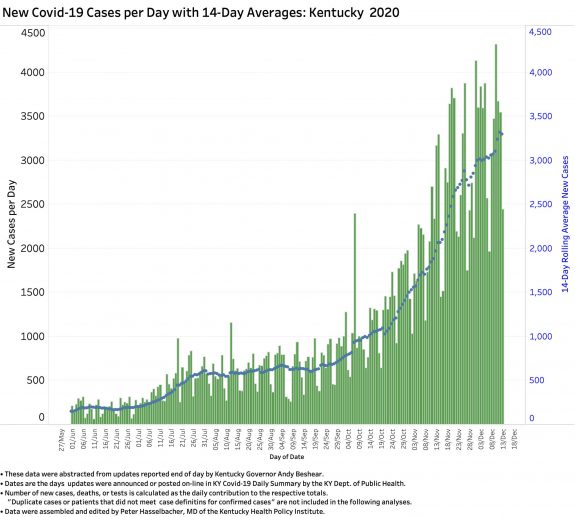
While the number of reported new cases last week was lower than the proceeding week, that drop is certainly due to delayed reporting of cases acquired during Thanksgiving week.
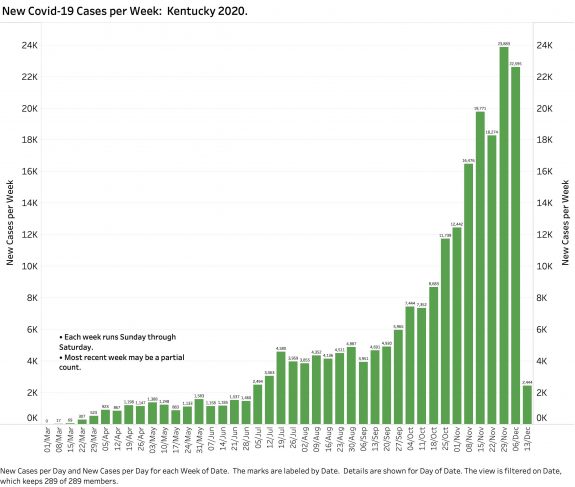
I have been using a semi-logarithmic plot of the 14-Day average of new cases to estimate the degree to which the exponential growth of the epidemic is changing and to allow for at least a short-term projection. It is otherwise hard to tell where we are going when an upward curve is pointing to the sky. It is correct to point out that in December, the data points have been falling below the trend line based on data from October 1. Hopefully things will stay that way and go even lower. However, if data from only December is used to generate a prediction, daily cases are still growing exponentially– just slower. We could see 5000 new cases per day by January 25. That is however a long way off and assumes nothing changes one way or the other– an unlikely occurrence.
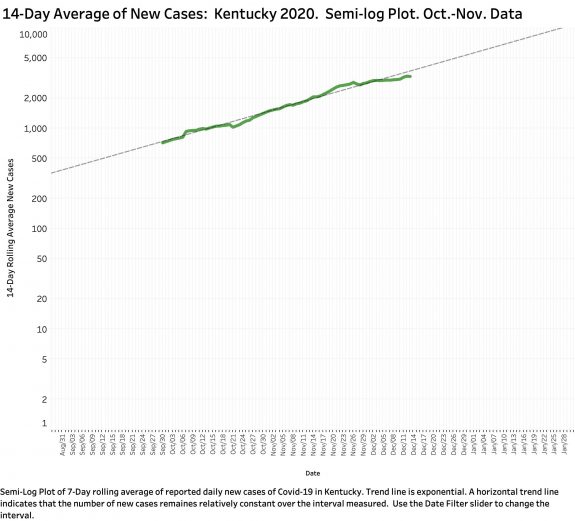
Deaths.
Weekly deaths fell a little last week also. Some of that is due to Thanksgiving week perturbations, but we have not yet seen all the deaths from infections acquired that holiday week. However, we are well ahead for the month. Not yet halfway through, we will surely overtake November’s deaths by large measure.
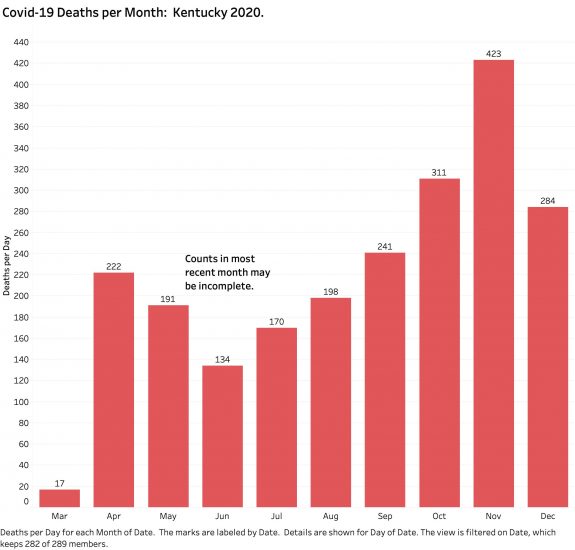
Hospital & ICU Utilization.
Current hospital and ICU utilization numbers have been oscillating in limited range in December but still at record numbers. ICU utilization has closely tracked overall hospital utilization. I do not know if demand for hospital services is declining, or if bed availability is being maxed out. We are all hearing that our hospitals and their staffs are being stressed badly. In some states, hospitals have been frankly overwhelmed and beds are becoming unavailable. There is no reason it could not happen in Kentucky.
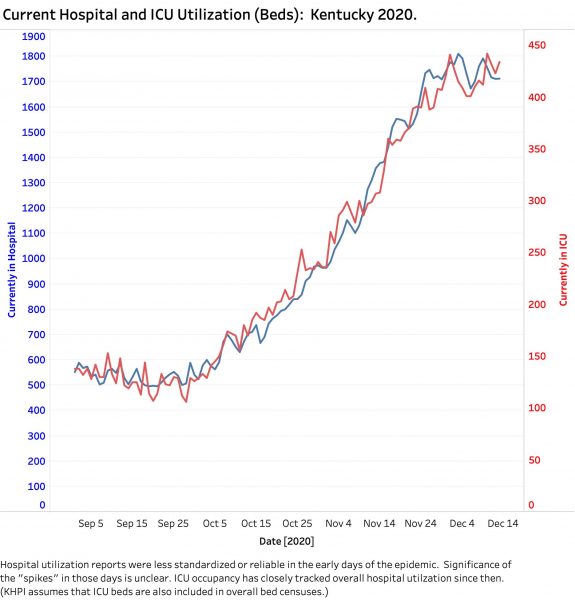
Ventilators.
Ventilator utilization is now being reported in Kentucky. According to data in the daily published reports, ventilator use has been rising along with ICU utilization although at a slower rate. Hospital staff have been working hard and with success in keeping patients from being intubated and placed on ventilators. Once a patient is placed on a ventilator, they tend to stay there for a while. Hospitals can, within limits, create new beds for intensive observation and care, and there are for some patients alternatives to ventilators to provide needed oxygen. Surely there are limits to growth in these alternatives. These limits include availability of trained staff to provide the necessary care.
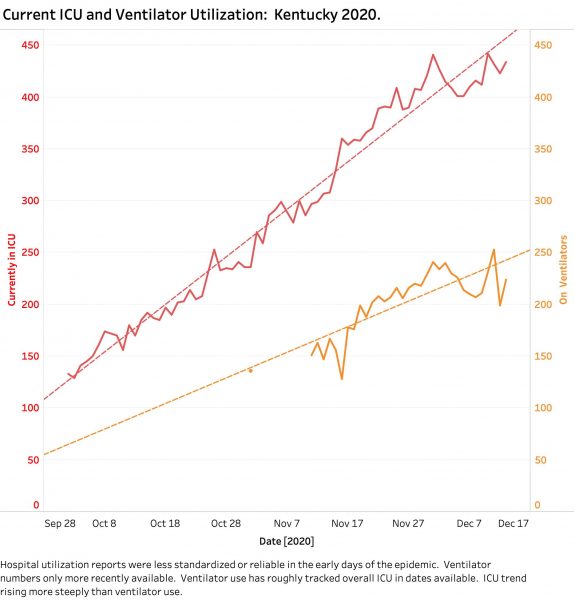
Testing Positivity Rate.
I confess that I do not feel knowledgeable enough or entirely comfortable in using the percent of tests that are positive as a measure of disease risk to the general population. The number of tests performed daily are subject to the same wide swings as reporting of cases. People can take those tests by choice, and testing reagents and service are by report becoming limiting again. As I understand it, the state has tried to take some of the variability out of the calculation by using a 7-Day average and including only those tests that are reported electronically by a limited number of major testing services. It may be that only PCR RNA tests are included. I am not sure. If the reported raw numbers of daily Total Tests and unique new cases are used, last week’s 7-Day average percent of tests that uncovered new cases ranged from 12 increasing to almost 15. These are as high as they have ever been in Kentucky. Without better understanding on what data is being used and how it is being calculated, I personally have more confidence in relying on changes in new cases and deaths, and incidence rates for a given population– especially in more local geographic areas.
We all want our epidemic to go away. No matter what we measure or how quickly vaccines become generally available, without more universal application state and national adherence to public health safety, it is going to take us a whole lot longer to get there, and we will have paid a much higher price in every important human dimension. One truism is that the few can take down the many. I admit to often being a glass-half-full kind of guy, but I fear that it is going to get a lot worse before we start to truly heal our multiple national tragedies. In the meantime, if you are going to ask people to do hard things, you need to support them. So I put it to our state and federal legislatures, surprise us and do your duty!
Peter Hasselbacher, MD
Emeritus Professor of Medicine, UofL
14 December 2010
